
- •CONTENTS
- •PREFACE
- •Content—Benefits for Students
- •Content—Benefits for Instructors
- •Features of the Book for Students and Instructors
- •Supplementary Materials
- •Acknowledgments
- •What Is Hospitality Management?
- •The Manager’s Role in the Hospitality Industry
- •Why Study in a Hospitality Management Program?
- •Planning a Career
- •Employment as an Important Part of Your Education
- •Getting a Job
- •Employment at Graduation
- •The Outlook for Hospitality
- •Summary
- •Managing Change
- •Demand
- •Supply
- •Workforce Diversity
- •The Impact of Labor Scarcity
- •Summary
- •The Varied Field of Food Service
- •The Restaurant Business
- •The Dining Market and the Eating Market
- •Contemporary Popular-Priced Restaurants
- •Restaurants as Part of a Larger Business
- •Summary
- •Restaurant Operations
- •Making a Profit in Food Service Operations
- •Life in the Restaurant Business
- •Summary
- •Chain Restaurant Systems
- •Independent Restaurants
- •Franchised Restaurants
- •Summary
- •Competitive Conditions in Food Service
- •The Marketing Mix
- •Competition with Other Industries
- •Summary
- •Self-Operated Facilities
- •Managed-Services Companies
- •Business and Industry Food Service
- •College and University Food Service
- •Health Care Food Service
- •School and Community Food Service
- •Other Segments
- •Vending
- •Summary
- •Consumer Concerns
- •Food Service and the Environment
- •Technology
- •Summary
- •The Evolution of Lodging
- •Classifications of Hotel Properties
- •Types of Travelers
- •Anticipating Guest Needs in Providing Hospitality Service
- •Service, Service, Service
- •Summary
- •Major Functional Departments
- •The Rooms Side of the House
- •Hotel Food and Beverage Operations
- •Staff and Support Departments
- •Income and Expense Patterns and Control
- •Entry Ports and Careers
- •Summary
- •The Economics of the Hotel Business
- •Dimensions of the Hotel Investment Decision
- •Summary
- •The Conditions of Competition
- •The Marketing Mix in Lodging
- •Product in a Segmented Market
- •Price and Pricing Tactics
- •Place—and Places
- •Promotion: Marketing Communication
- •Summary
- •The Importance of Tourism
- •Travel Trends
- •The Economic Significance of Tourism
- •The United States as an International Tourist Attraction
- •Businesses Serving the Traveler
- •Noneconomic Effects of Tourism
- •Summary
- •Motives and Destinations
- •Mass-Market Tourism
- •Planned Play Environments
- •Casinos and Gaming
- •Urban Entertainment Centers
- •Temporary Attractions: Fairs and Festivals
- •Natural Environments
- •On a Lighter Note. . .
- •Summary
- •Management and Supervision
- •The Economizing Society
- •The Managerial Revolution
- •Management: A Dynamic Force in a Changing Industry
- •What Is Management?
- •Summary
- •Why Study Planning?
- •Planning in Organizations
- •Goal Setting
- •Planning in Operations
- •The Individual Worker as Planner
- •Long-Range Planning Tools
- •Summary
- •Authority: The Cement of Organizations
- •Departmentalization
- •Line and Staff
- •Issues in Organizing
- •Summary
- •Issues in Human-Resources Management
- •Fitting People to Jobs
- •Recruiting
- •Selection and Employment
- •Training
- •Retaining Employees
- •Staff Planning
- •Summary
- •The Importance of Control
- •Control and the “Cybernetic Loop”
- •Tools for Control
- •Summary
- •Leadership as Viewed by Social Scientists
- •Why People Follow
- •Leadership Theories
- •Communication
- •The Elements of Leading and Directing
- •Developing Your Own Leadership Style
- •Summary
- •A Study of Service
- •Rendering Personal Service
- •Managing the Service Transaction
- •How Companies Organize for Service
- •Summary
- •INDEX

268 |
Chapter 9 Lodging: Meeting Guest Needs |
7.Explain why international travel is important to the industry, and describe what operators can do to develop this source of business.
8.Give examples of how technology has impacted lodging in the following areas: sales, marketing, guest amenities, and services.
9.Describe how AAA and the Mobil Travel Service evaluate lodging properties, and identify criteria used in determining these ratings, as well as describe how countries around the world approach the rating of hotels.
10.. Define the term internal customer, and explain the importance of this concept in the delivery of quality service to guests.
The Evolution of Lodging
Today in the United States, there are 47,590 lodging properties containing over 4.4 million guest rooms. In 2005, this dynamic industry generated $122.7 billion in sales and directly supported over 7.5 million travel and tourism jobs.1 The industry has
surely come a long way since its origins.
THE HISTORY OF LODGING
The history of lodging, leading to this enormous growth, is rich in variety and encompasses thousands of years. The Code of Hammurabi dating back to about 1800 B.C., made a reference to “tavern keeping,” another term used for innkeeping in that day. Later, the Romans built an extensive system of paved roads and included way stations and inns at regular intervals along the way. During the Middle Ages in Europe, religious pilgrimages were the primary reason for traveling, with charitable institutions and religious orders providing lodging facilities. In the fifteenth century, many European cities became centers of commerce and culture. Correspondingly, innkeeping for profit began. With the development of stagecoach routes connecting major cities, the first hotel boom occurred as inns were located along these routes. The development of inns along stagecoach routes was later followed by the location of lodging establishments convenient to the major travel modes of railroads, automobiles, and airplanes as the lodging industry responded to changes in destination patterns.2
In the American colonies of the seventeenth and eighteenth centuries, inns and taverns were important centers of activity. As meeting places for colonists planning to separate from England, the early inns were sometimes called “cradles of liberty.” The inns of Colonial America, called “ordinaries,” typically provided the midday meal

The Evolution of Lodging |
269 |
or supper as part of the overnight stay. By the beginning of the nineteenth century, lodging establishments that were larger and more commercial than inns emerged, along with the term hotel. Early hotels in the United States included the six-story, 200-room City Hotel in Baltimore, built in 1826, and the Tremont House in Boston, built in 1829.3
Luxury hotels were still the exception in the United States during the nineteenth century, however. The grand hotels of the world were, for the most part, still in Europe, including such landmarks as the Grand Hotel in Rome, the Paris Ritz, and the Savoy of London. The Waldorf Hotel in New York City was one of the first properties in the States to provide many of the European amenities. Built in 1893 by William Waldorf Astor, the Waldorf was followed by larger and more elaborate hotels such as the Astoria Hotel, also in New York. A later combination of these two properties created the Waldorf-Astoria Hotel, which was the world’s largest hotel of its day.4
Toward the end of the nineteenth century, North American hotels grew to serve the rail traveler. Often the hotel was physically connected to the railroad station. A few of these hotels still survive, and some, such as Toronto’s Royal York, remain thriving centers. Of the hotels built during the first half of that century, those not physically connected to the railroad station were usually convenient to it and to the major destinations in the downtown sections of cities.5
By 1900, there were still fewer than 10,000 hotel properties of varying service levels throughout the United States. A typical luxury hotel might offer amenities such as steam heat, electric call bells, baths and clothes closets on all floors, barbershops, and liveries. The Hotel Statler chain, which started in Buffalo, New York, served as the model for construction of hotels for the next 40 years. With the opening of the Buffalo hotel in 1908, rooms had private baths, full-length mirrors, and telephones. The marketing slogan for the Statler Hotel in Buffalo was “A bed and a bath for a dollar and a half.” Other Statler properties that followed were also known for the introduction of many firsts.6 In 1927, the Hotel Statler in Boston became the first hotel with radio reception; individual headsets were provided in each guest room to receive broadcasts from a central control room.7 The Hotel Statler in Detroit, which opened in 1934, was the first property to have central air-conditioning for every public room.
By 1910, there were 1 million total hotel guest rooms in the United States, with the industry employing some 300,000 people. The average property of that day had between 60 and 75 guest rooms.8 The first two decades of the twentieth century saw the beginnings of several major hotel companies that are still prominent today. Conrad Hilton entered the hotel business in 1919 by acquiring the 40-unit Mobley Hotel in Cisco, Texas. Ernest Henderson, founder of Sheraton Hotels, acquired four hotels in the late years of the Depression, with the chain’s name coming from one of these four hotels, the Sheraton Boston Hotel.9 Around the same era, J. Willard Marriott Sr. entered the hospitality industry with the opening of his first root beer stand in 1927.

270Chapter 9 Lodging: Meeting Guest Needs
This modest beginning led to the Marriott name as a multi-billion-dollar giant in the lodging industry.10
THE EVOLUTION OF THE MOTEL
The Federal Road Aid Act of 1916 resulted in a new segment of the lodging industry, as thousands of rooms were added in properties along the new state and federal highways being constructed. The first roadside “motel” opened in San Luis Obispo, California, in 1925 with room rates of $2.50 a night. Sometimes referred to as “tourist courts,” the first motels were small, simple affairs, commonly with under 20 units (or guest rooms). These properties lacked the complex facilities of a hotel and were generally managed by resident owners with a few paid employees. The big wave of motel construction followed World War II, accompanying the explosive growth in auto travel.
Motels tended to be built at the edge of town, where land costs were substantially lower than downtown. The single-story construction that typified motels until the late 1950s (and even the two-story pattern of later motor hotels) was significantly less expensive compared with the downtown high-rise properties that were built on prime real estate. Capital costs, such as land and building, represent the largest single cost in many lodging establishments, and so lower land and building costs and the lower capital costs that resulted gave motels significant advantages. These savings could be, and generally were, passed on to guests in the form of lower rates.
Probably more important was the fact that motels offered a location convenient to the highway. Because the typical guest traveled by car, he or she could drive to any local destination during the day, returning to the accommodations in the evening. Meanwhile, inexperienced travelers, who had always been put off by the formality of hotels, with their dressy room clerks, bell attendants who had to be tipped, and ornate lobbies, preferred the informal, come-as-you-are atmosphere of motels. In the motel, they might be greeted by the owner working the front desk. Motel operators were proud of their informality. The personal touch they offered guests and the motel’s convenience and lower prices were their stock-in-trade.11
THE MOTOR HOTEL
For a few years, it appeared that hotels (in general, the relatively large downtown properties) and motels (usually, the small properties located at the edge of town) would battle for the new mobile tourist market. Unhappily for both the hotel and the mom- and-pop motel, the situation was not that simple.
In 1952, Kemmons Wilson, a Memphis home-building and real-estate developer, took his family on a vacation trip. He was depressed by the dearth of accommodations

Classifications of Hotel Properties |
271 |
to meet his family’s and the business traveler’s needs. He returned to Memphis with a vision of a new kind of motel property that combined the advantage of a hotel’s broad range of services with a motel’s convenience to the auto traveler. That insight, which came to be known as the motor hotel, revolutionized the lodging industry.
Motels became larger and began to offer a wide range of services. Dining rooms or coffee shops, cocktail lounges, and meeting rooms appealed to the business traveler. Swimming pools became essential to the touring family. Room telephones, usually present in hotels but generally absent in motels, became the rule in motor hotels, thus requiring a switchboard and someone to operate it. Whereas hotels and motels had offered coin-operated radios and television, free television and then free color television became the rule.
Although there were experiments with smaller inns having 50 to 75 rooms, most lodging companies determined that generally a 100-unit facility was the smallest that made economic sense. That size permitted full utilization of the minimum operating staff and provided sufficient sales to amortize the investment in such supportive services as pools and restaurants. However, with the advent of the limited-service hotel, which does not include a restaurant, smaller properties in small cities are once again feasible.12
The basic distinction between hotels and motels has become more complex as different types of lodging properties have emerged since the advent of the motor hotel of the 1950s. Today’s lodging properties fall into one of several categories, with some blurring of distinctions between lodging types. Many major hotel corporations, such as Marriott, have properties in each lodging category, addressing the varied needs of different market segments of travelers.
Many lodging properties are part of larger chain operations, typically with recognizable brand names, and corporately owned or franchised. Other properties, smaller in number, are known as independents; here the owner may be one or several individuals or a company but has no ties to a larger corporation or major brand name. Industry Practice Note 9.1 looks at the state of hotel chain affiliations in Europe (this topic is also explored further in Chapter 12 as it relates to U.S. properties).
Classifications of Hotel Properties
Lodging properties can be categorized according to varied criteria. Classification criteria can include price, function, location, particular market segment, and distinctiveness of style or offerings. It should be emphasized that many types of hotels can
fall into more than one category.

INDUSTRY PRACTICE NOTE 9.1
Europe: A Continent of Lodging Distinctiveness
While some parts of the world such as Asia and the Middle East are experiencing rapid hotel growth, Europe remains the leader in hotel capacity. According to the World Tourism Organization (WTO), about 38 percent of the six worldwide tourism regions are located in Europe. European hotels are distinctive, compared to the other tourism regions, in that properties tend to be older and smaller in the number of rooms. European hotels also tend to be more fragmented, compared to other parts of the world, in that only 20 percent to 25 percent of room capacity is branded by an integrated chain. In North America, approximately 70 percent of hotels are chain-managed or franchised. Other regions of the world fall somewhere in between North America and Europe.
The degree of chain penetration in Europe varies by country. For example, France has the highest percentage of hotel rooms affiliated with a chain (not including consortia) at 38 percent. Spain follows (34 percent) along with Germany (24 percent) and Ireland (21 percent). Significant reduced affiliations exist in Italy (4.4 percent) and Switzerland (8 percent).
Paris-based Accor has the largest number of properties with 1,922 hotels (201,042 rooms) in Europe carrying their flag. In Europe, Accor manages the well-known brands of Ibis, Mercure, Novotel, Formula 1, and Etap. Accor also has the upscale brand of Sofitel and the extended stay brand of Suitehotels.
InterContinental Hotel Group also has a significant presence with 423 properties and 68,841 rooms in Europe and Societe du Louvre with 918 properties and 62,856 rooms. InterContinental’s brands include Holiday Inn, Express by Holiday Inn, Crowne Plaza, InterContinental, and Staybridge Suites. Societe du Louvre is a publicly held company controlled by the Tattinger family (known for being Champagne producers). Their brands include the upscale Groupe Concorde hotels and budget Groupe Envergure. Hilton Group, a British-based chain with the rights to use the Hilton name outside the United States, also has a presence in Europe with 118 hotels containing 28,501 rooms.
The best affiliation solution for the average European hotel tends to be the voluntary chain or consortium option. These synonymous terms refer to a loosely structured hotel grouping which require less of the individual hotelier in terms of costs and prescribed standards. The affiliation with the voluntary chains is typically easier to cancel (usually within two years or less) whereas cancellations with the more structured hotels can stretch over several decades. While Switzerland, for example, has only 8 percent of its hotels affiliated with the “hard brand chains,” an estimated 27 percent are affiliated with a consortium.
On the side of the chains, the usual European hotel is not as attractive as properties in other parts of the world. The smaller size and the location of many European hotels are not good fits with the larger worldwide chain model. Urban locations are preferred or close access to major transportation arteries by the large chains.
The major chains have recently lost capacity in Europe. One reason is linked to the tightening of standards by the consortia. Best Western, for example, added fourteen new operating standards. Best Western conducts yearly inspections of their properties as does Logis de France (with almost 4,000 hotels), the voluntary chain of Relais & Chateaux.
Source: M. Marvel, “Hotel Chain Penetration in Europe—Understanding the European Hotel Market,” for EHLITE.com, January 8, 2004, http://ahlaradio.hsyndicate.com/news/4018166.html
272
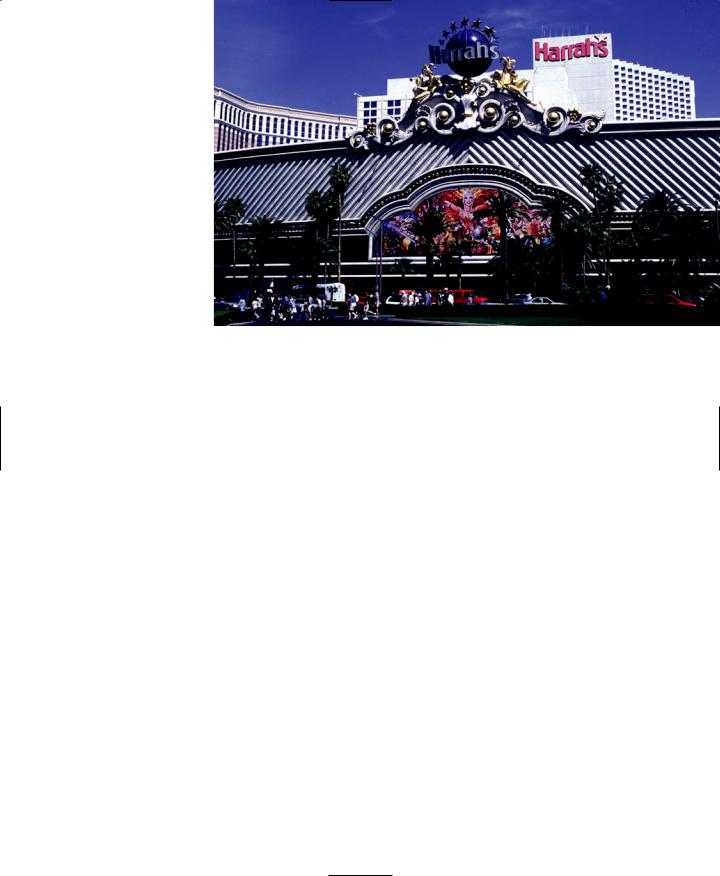
Hotels come in many different sizes and offer room rates for all types of customers. (Courtesy of Las Vegas
Convention and Visitors Authority.)
HOTELS CLASSIFIED BY PRICE
Categorized by price, lodging properties can range from limited-service hotels to fullservice properties and up to luxury hotels.
Limited-Service Hotels. Limited-service hotels typically offer guest rooms only. There is little or no public space, no meeting or function space, and usually no or very limited food and beverage facilities. Room rates are correspondingly lowest for this type of lodging property. Terms previously used for this classification of properties included “budget” or “economy” hotels. The average daily rate per occupied room for limited-service hotels in 2005 was $71.35. The average size of this type of property in 2005 was 126 rooms. Business travelers make up 50.8 percent of the market mix for limited-service hotels followed by tourist or leisure travelers at 44.4 percent. Conference, convention, and other travelers account for 4.8 percent.13
Full-Service Hotels. Full-service hotels offer a wide range of facilities and amenities. Usually there will be, in comparison to budget/economy properties, more public space and meeting/function space, with at least one food and beverage facility. Room rates tend to be equal to or slightly above market-area average. In 2005, the average rate for full-service hotels was $127.20. These properties had, on average, 286 rooms and catered primarily to business travelers (41.5 percent), leisure travelers (27.3 percent), convention travelers (17.1 percent), conference attendees (7.4 percent) and other (6.7 percent).14
273

274Chapter 9 Lodging: Meeting Guest Needs
Luxury Hotels. At the top of the price category are the luxury hotels, which usually have from 150 to 400 guest rooms. Featuring upscale decor and furnishings that may be unique to the particular hotel, these properties offer a full array of services and amenities. Such hotels would typically have a concierge service and several food and beverage operations, including a gourmet or fine-dining restaurant, banquet facilities, and full room service (available 24 hours per day or close to this). Recreational facilities or access for guests to nearby facilities is also usually available. There is a high ratio of employees to guest rooms, and room rates are considerably above the market-area average. In the buying and selling of luxury properties in the United States, selling prices have reached $1 million per room for some hotels. In Milan, Italy, $2 million was paid per room for a luxury property in late 2006. One of the recent trends contributing to the climbing prices of these properties, has been high-end corporations such as Italian jeweler Bulgari and fashion designers Versace and Giorgio Armani entering the luxury hotel market.15 The average daily rate for luxury chain hotels in the United States for the first part of 2006 was $273.66 according to Smith Travel Research. For that same time period, the average rate for the U.S. hotel industry as a whole was $96.42. Luxury hotels had an average occupancy rate of 71.6 percent compared to the overall hotel market with an average occupancy of 62 percent. As Joe McInerney, president and CEO of the American Hotel and Lodging stated: “The luxury hotel market is better than it has ever been. The economy is good. People are buying up. They feel good . . . (about their personal finances) and want to travel luxuriously while they can.”16
HOTELS CLASSIFIED BY FUNCTION
Hotels categorized by function include convention hotels and commercial hotels.
Convention Hotels. Convention hotels are large, with 500 or more guest rooms. The average size of convention hotels in 2005 was 780 rooms. These properties offer extensive meeting and function space, typically including large ballrooms and even exhibition areas. Food and beverage operations tend to be extensive, with several restaurants and lounges, banquet facilities, and room service. Convention hotels are often in close proximity to convention centers and other convention hotels, providing facilities for citywide conventions and trade shows.17
Commercial Hotels. Commercial hotels, in comparison to convention hotels, are smaller, with 100 to 500 guest rooms. There is less public space, smaller meeting and function space, fewer food and beverage outlets, and limited recreational amenities. Many of these hotels tend to be located in downtown areas. Downtown properties (also
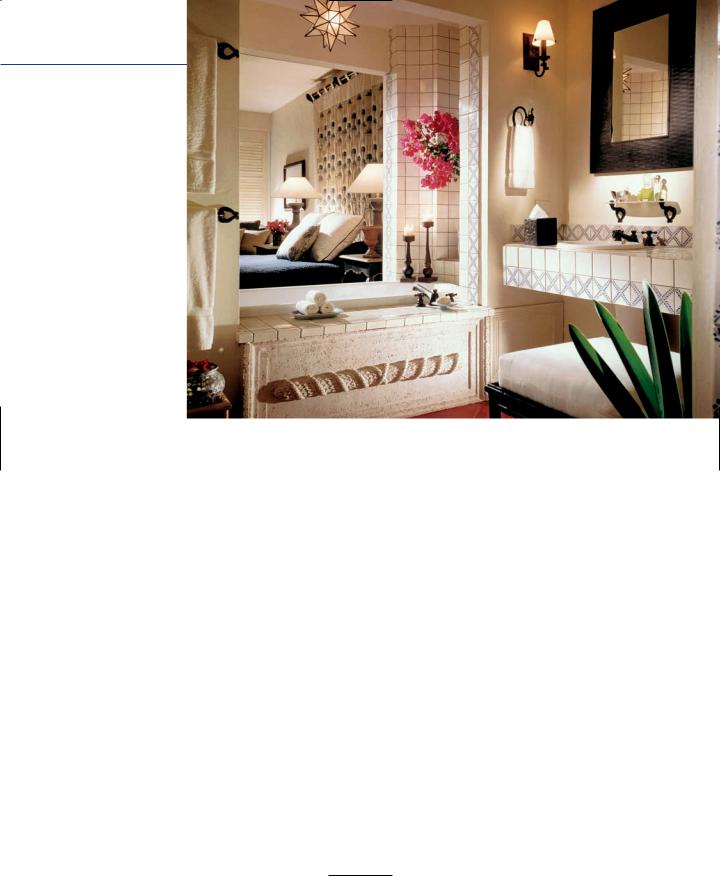
Luxury hotels cater to a guest’s every need. (Courtesy of Rosewood Hotels & Resorts.)
mentioned in the next section) have many advantages. They are near the large office complexes and retail stores; by day, they are near business destinations; by night, they are close to many of a large city’s entertainment centers. Many well-located older downtown properties have also been remodeled to include necessary facilities. Although onpremise parking has not always been feasible, reasonably convenient off-premise parking with valet service to pick up and deliver the car is common. Thus, nearly all first-class downtown properties are reasonably “auto friendly.” One final note: Downtown hotels almost always command higher rates. The higher rate is needed to offset the higher land cost and to cover the cost of whatever public facilities they might have.18
Figure 9.1 illustrates some different operating characteristics of hotels in different property categories.
HOTELS CLASSIFIED BY LOCATION
Location can also be a criteria for categorizing lodging properties. Types of hotels under this categorization include downtown hotels (discussed above), suburban hotels, highway/interstate hotels, and airport hotels. Suburban hotels tend to be smaller (200 to 350 guest rooms) and involve lowto mid-rise structures. Highway/interstate hotels are even smaller, with 100 to 250 rooms, and are low-rise properties.
275

276 |
Chapter 9 Lodging: Meeting Guest Needs |
T Y P E O F L O D G I N G |
O C C U P A N C Y |
A V E R A G E D A I L Y |
P R O P E R T Y |
P E R C E N T A G E |
R O O M R A T E |
Full-Service Hotels |
70.5% |
$127.20 |
Limited-Service Hotels |
69.4% |
$71.35 |
Resorts |
72.2% |
$180.96 |
Suite Hotels |
75.0% |
$108.35 |
Convention Hotels |
71.3% |
$166.10 |
All Hotels |
71.4% |
$126.12 |
Source: Data from Hospitality Research Group, PKF Consulting, Trends 2006.
Figure 9.1
Average Occupancy and Average Room Rate for U.S. Hotels in 2005
The San Francisco Marriott is a prime example of a downtown high-rise hotel. (Courtesy of Marriott International.)
Suburban hotels would most likely have interior corridors and meeting and banquet facilities, whereas the highway/interstate properties most likely have exterior corridors leading to guest rooms, minimal banquet and meeting space, and some food and beverage facilities.
In the 1950s and 1960s, as air travel became more and more common, a new kind of property appeared, designed especially to accommodate air travelers. Airport hotels vary depending on location and size of the airport, with such properties offering a mix of facilities and amenities. Typically, airport hotels range from 250 to 550 rooms.19 An important extra service provided by almost all airport hotels is the courtesy van, which offers guests transportation to and from the airport.
HOTELS CLASSIFIED BY MARKET
SEGMENT
Particular markets served include executive conference
centers, resorts, and health spas.
Executive Conference Centers. Executive conference centers are often in
secluded or suburban settings and have fewer than 300 guest rooms. These facilities, which
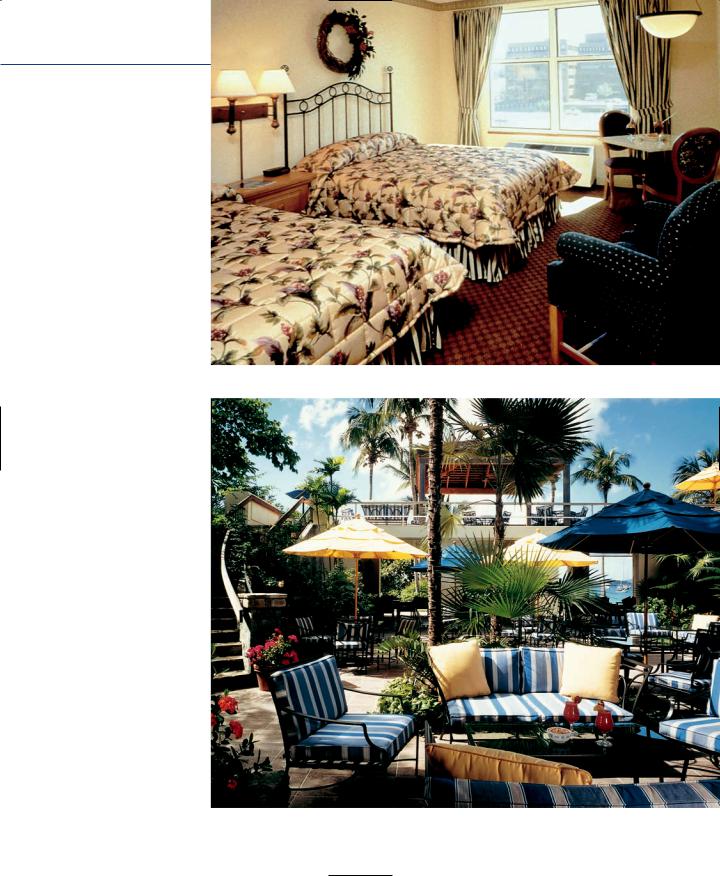
Modern guest rooms can accommodate a variety of needs and types of guests. (Country Inns and Suites; Courtesy of Carlson Hotels Worldwide.)
Resort hotels provide ample opportunity for guests to relax in picturesque surroundings. (Courtesy of Rosewood Hotels & Resorts.)
277

278Chapter 9 Lodging: Meeting Guest Needs
offer well-designed learning environments, provide a variety of small meeting rooms and classrooms featuring full audiovisual and technological support. Meals and use of recreational facilities are often included in the quoted daily room rate. An example of an Executive Conference Center is the Georgia Tech Hotel & Conference Center in Atlanta, GA.
Resorts. Resorts are typically located in picturesque settings and have 200 to 500 guest rooms. An example of a well-known resort in the United States is The Breakers, West Palm Beach, FL. Resorts provide a comprehensive array of recreational amenities, depending on the geographic location. A variety of food and beverage outlets is available, ranging from informal to fine-dining restaurants. With many resorts located in remote locations, it is often not feasible for guests to have to leave the property for dining options. Resorts can be further characterized and defined in more explicit terms. Some resorts are “destination resorts”; these tend to be in dramatic, desirable locations such as Hawaii, Mexico, and the Caribbean. Hotel guests tend to have to travel at least several hundred miles to reach such a resort, and travel is typically by air. Visits to destination resorts tend to be infrequent, usually once a year or less. Nondestination resorts or regional resorts involve a twoto three-hour trip for visitors and are usually traveled to by car. The visits to such locations are more frequent but usually for shorter periods of time as compared to the destination resorts. It is very feasible for a resort to cater to both destination and nondestination visitors.20 Resorts can also be classified on a seasonal basis, indicating the time of year when the resort is at a peak demand. Seasonal classifications include summer, cold winter (i.e., ski resorts), warm winter (such as south Florida or southern Arizona), and year-round. At one time, the majority of resorts operated seasonally. Today, most resorts operate year-round, with group business and lower-rate packages bringing in guests during the less desirable times of the year. Two cities that epitomize the year-round resort market are Las Vegas, Nevada, and Orlando, Florida. Orlando, with almost 113,000 hotel rooms,21 and Las Vegas, with over 133,000 rooms (and 59 hotels with 48,292 more rooms in the pipeline)22 lead the nation in hotel room inventory, surpassing even Los Angeles, Chicago, and New York City.
An interesting segment of resorts focuses on ecotourism. These typically remote lodging establishments are usually located in areas of significant natural beauty, and the design elements of the property blend with the surroundings and protect the ecosystem. Often incorporated with adventure travel, these lodging properties can be found from the Great Barrier Reef of Australia to the rugged highlands of Tasmania and the jungles of Costa Rica. As with P&O Australian Resorts, many of these hotels stress comfort, with luxurious rooms and gourmet food and beverage selections.23
Casino Hotels. Casino hotels and resorts24 differ significantly in their operation compared to most hotels. In casino hotels and resorts, gaming operations are the
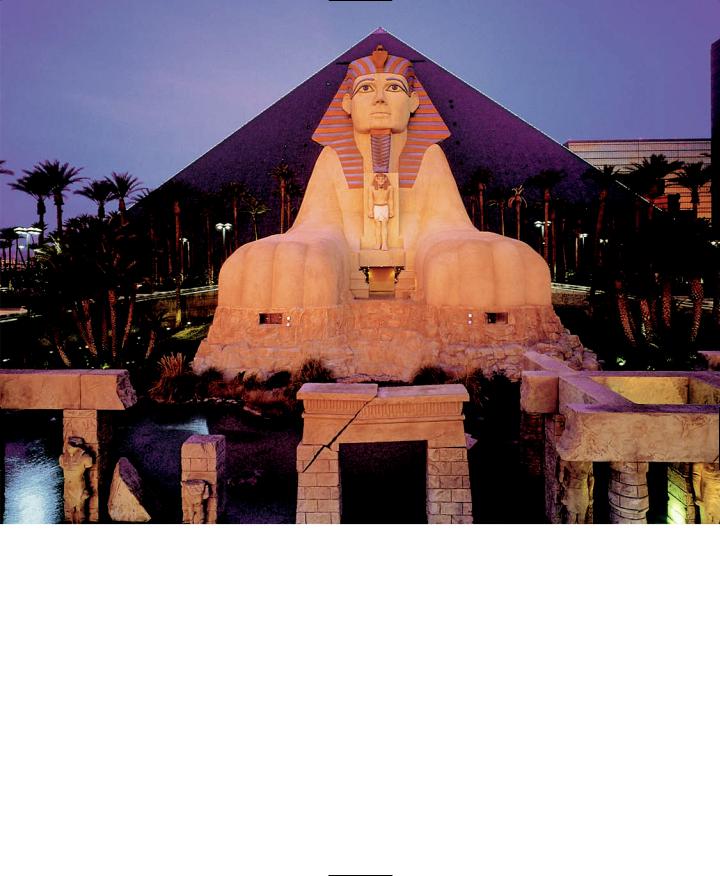
Casino hotels such as the Luxor in Las Vegas use architecture to convey the desired image of the property. (Courtesy of Luxor Casino Hotel, Las Vegas.)
major revenue centers. Most of these are in Las Vegas; a number of casino operations that include hotels are also located on Native American reservations throughout the United States. Casino operations are discussed more fully in Chapter 14. There are numerous examples of casino hotels discussed throughout the text. One well-known casino hotel in the United States is Wynn Las Vegas.
Health Spas. Health spas, often located in resort-type settings or as a part of a larger resort, provide additional amenities focusing on needs ranging from losing weight to reducing stress to pampering oneself. Resort/hotel spas are the second largest category next to day spas. Resort/hotel spas were also the fastest growing segment over the past five years, growing 290 percent between 1999 and 2004. Spas are increasingly being considered as a necessity to remain competitive in attracting both leisure and
279

280Chapter 9 Lodging: Meeting Guest Needs
business travelers. In a sample of 88 U.S. properties, spa revenue for hotels averaged $2,076 per available room or 2.3 percent of total revenue. At resort properties, spa revenue was $3,117 per available room or 3.4 percent of total revenue. In comparison, golf revenue declined by 2.7 percent per occupied room.25
Spas have professional staffs that often include dietitians, therapists, masseurs, exercise physiologists, and in some cases, physicians. There are a number of categories of spas, including spas with natural mineral hot springs, beauty spas, fitness spas, in- ternational-style spas that emphasize health therapies, behavior modification spas, holistic spas, resort spas, and spa facilities within hotels.26 Hotels providing spa and fitness facilities are now dedicating more space to comprehensive health facilities in order to remain competitive. With an aging population of 80 million baby boomers, more health-oriented services are expected as this segment focuses on improving the quality of life. Profits will also play a very big part in fitness centers and spas, as resorts and hotels realize the significant revenue potential. Industry Practice Note 9.2 describes several trends in spa services. A prominent health spa in the United States is The Boulders Resort and Golden Door Spa, Phoenix, AZ.
Vacation Ownership. Vacation ownership, also referred to as timeshares and vacation intervals, involves a “type of shared ownership in which the buyer purchases the right to use a residential dwelling unit for a portion of the year.”27 Major lodging companies such as Marriott, Ritz-Carlton, Four Seasons, Hyatt, Accor, Carlson, Starwood, and Disney are big holders of the vacation ownership market. In 2006, 4.1 million households owned one or more U.S. timeshare properties. There are 154,439 timeshare units at over 1,600 resorts throughout the United States. Each condominium or unit of a vacation ownership resort is divided into intervals, typically by the week, that are sold separately. The condominiums are priced according to a variety of factors including unit size, resort amenities, location, and season. Purchasers of vacation ownership properties can typically travel to other destinations through vacation exchange programs provided through the timeshare resort developers. The predominant type of timeshare property, according to the American Resort Development Association, is a seaside/ocean resort (31.9 percent) followed by regional resorts (13.7 percent) and golf resorts (10.2 percent). Florida has three times as many timeshare resorts as any other state with the number totaling close to 400.28 Marriott Vacation Club Sunset Pointe, Hilton Head, SC is a good example of a Vacation Ownership facility.
OTHER HOTEL CLASSIFICATIONS
Types of hotels classified by distinctiveness of style or offerings include all-suite properties, extended-stay properties, historic conversions, and bed-and-breakfast inns. Boutique hotels can also be classified under this category.

INDUSTRY PRACTICE NOTE 9.2
Trends in Spa Operations
According to the International Spa Association, spas are the fourth-largest leisure industry in the United States. Not only are spas growing in number (13,757 in the United States) and locations (9 percent are in hotels or resorts), but they are growing in the types of services provided. Some of the latest trends include the following:
■Authenticity: Destination spas and resort hotel spas are differentiating themselves with the types of products and services of their region. For example, Cliff House Resort & Spa in Ogunquit, Maine, offers body wraps made from Maine blueberries and wild roses or juniper berries. Le Spa at the Radisson Plaza Resort in Papeeta, Tahiti, offers treatments featuring the traditional monoi oil used by locals.
■Wellness: Canyon Ranch Resorts, in Lenox, Massachusetts and Tucson, Arizona, are collaborating with the Cleveland Clinic in Ohio to offer programs in weight control, stress management, and cardiac care.
■Medical tourism: This controversial field is booming and is increasingly using new technology such as DNA analysis, antiaging treatments, BOTOX®, and laser surgery. Medical tourism agencies now exist to help arrange the traveler-patient’s stay.
■Sleep therapy: Spas increasingly will be offering sleep techniques and treatments to a society that generally is sleep-deprived.
■Men: The International Spa Association states that 31 percent of spa-goers are men. The Lodge at Woodloch, in Hawley, PA, was designed with male-focus including lodge-style architecture, a golf course, full bar with tapas and a dinner menu that includes red meat.
■Labor Concerns: Because of the high cost of labor, particularly in the United States, spas are increasingly using “de-staffed” spa treatments including heat and water experiences. Pricing will also become more attuned to demand with treatments during busy timeframes (weekends, for example) costing more than lower-demand times (weekdays).
■Fusion: Fusion treatments and techniques are on the increase. Examples include Watsu (water and shiatsu), yogalates (yoga and Pilates), Neurobics (mind aerobics) and Kinesis (mind-exercise).
■Services for Children: The spa industry is responding to the growth in family travel with more spas adding children’s activities. Children’s activities are being offered in many locations while parents indulge in spa treatments. Spa services especially designed for children, such as chocolate manicures, are also creative additions.
Source: “2007 Spa Trends,” Staff and Wire Services, January 7, 2007. North Jersey Media Group, Inc. Proquest Information and Learning, http://global.factiva.com/ha/default.aspx
All-Suite Hotels. All-suite hotels became known as a separate category in the 1970s. Guest rooms are larger than the normal hotel room, usually containing more than 500 square feet. A living area or parlor is typically separate from the bedroom, with some properties offering kitchen areas. All-suite hotels can be found in urban, suburban, and
281

282 |
Chapter 9 Lodging: Meeting Guest Needs |
15'0'' |
8'4'' |
13'0" |
12'10"
Figure 9.2
A typical guest unit at Embassy Suites. (Source: Embassy Suites.)
even residential locations. The amenities and services (availability of on-site restaurant operations, meeting space, and recreational facilities) can vary widely in this type of hotel. Figure 9.2 shows a typical guest unit at an Embassy Suites.
Extended-Stay Hotels. Extended-stay hotels provide many of the same features and amenities as the all-suite properties, such as a stove and/or microwave in the guest rooms, refrigerators, kitchenware or dishes, grocery shopping service, business services, and limited housekeeping service. As compared to all-suite hotels, however, the extended-stay room rates are often significantly less, with daily, weekly, and monthly rates quoted. Restaurants may be located nearby; typically there are no on-site food and beverage outlets in extended-stay hotels.29
Historic Conversions. Some hotel properties have historic significance and have been renovated to their original splendor. These classic hotels have great appeal for those wishing to experience some of the grandeur and elegance of earlier days with the comforts of modern-day features.
Bed-and-Breakfast Inns. A bed-and-breakfast inn (B&B) typically has five to ten rooms with the average size being eight rooms. Breakfast is served and included in the room rate for these properties. Most B&Bs are outside of urban areas with 29 percent being in rural locations and 52 percent being in suburbs/villages. The average length of ownership of a B&B is 13 years and most owners (88 percent) live on the
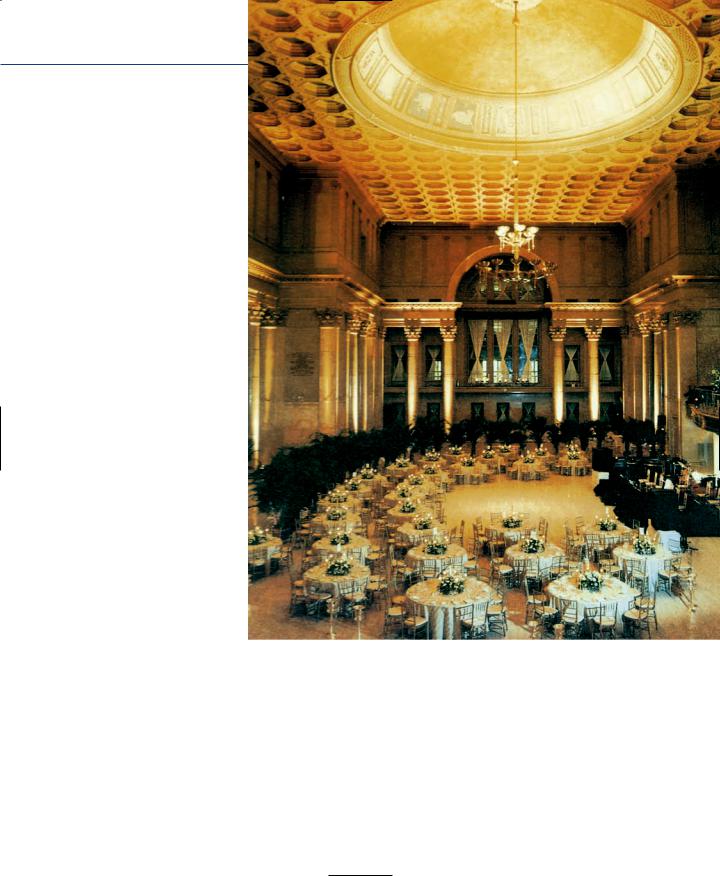
The Regent Wall Street is a good example of a beautifully restored boutique hotel. (Courtesy of Carlson Hotels Worldwide.)
premises. The number of B&Bs has increased from fewer than 1,000 in 1980 to about 20,000 properties today encompassing 148,000 rooms.30
Boutique Hotels. Boutique hotels span all price segments and are noticeably different in look and feel from traditional lodging properties. Interior-design styles in boutique hotels range from postmodern to homey. Soft attributes, such as image and
283

284 |
Chapter 9 Lodging: Meeting Guest Needs |
B Y L O C A T I O N |
P R O P E R T Y |
R O O M S |
Suburban |
15,853 |
1,570,134 |
Highway |
6,761 |
452,017 |
Urban |
4,595 |
700,267 |
Airport |
1,933 |
274,769 |
Resort |
3,835 |
573,092 |
B Y R A T E |
P R O P E R T Y |
R O O M S |
Under $30 |
857 |
52,830 |
$30–$44.99 |
7,518 |
405,028 |
$45–$59.99 |
10,850 |
669,174 |
$60–$85 |
16,562 |
1,329,544 |
Over $85 |
11,803 |
1,945,890 |
B Y S I Z E |
P R O P E R T Y |
R O O M S |
Under 75 rooms |
27,416 |
1,160,329 |
75–149 rooms |
14,432 |
1,532,477 |
150–299 rooms |
4,182 |
836,554 |
300–500 rooms |
1,062 |
396,544 |
Over 500 rooms |
498 |
476,562 |
Source: AH&LA, 2006 Lodging Industry Profile |
|
|
Figure 9.3
2005 Property/Room Breakdown
atmosphere, typically distinguish these properties. Travelers’ desires to be perceived as trendy, affluent, and artistic tie into boutique themes. Starwood Hotels & Resorts Worldwide has a version of the boutique concept with their W properties.31
Figure 9.3 displays types of hotels by location, rate, and size, along with the approximate percentage of U.S. properties that fall into these categories. Of the total number of lodging properties in the United States, it is interesting to note that 57.6 percent have fewer than 75 rooms, and 30.3 percent have 75 to 149 rooms. Although megahotels often garner much attention, the impact of small businesses on lodging is extremely significant. Slightly over three percent (3.2 percent) of the U.S. hotel inventory is comprised of properties with three or more rooms.32
